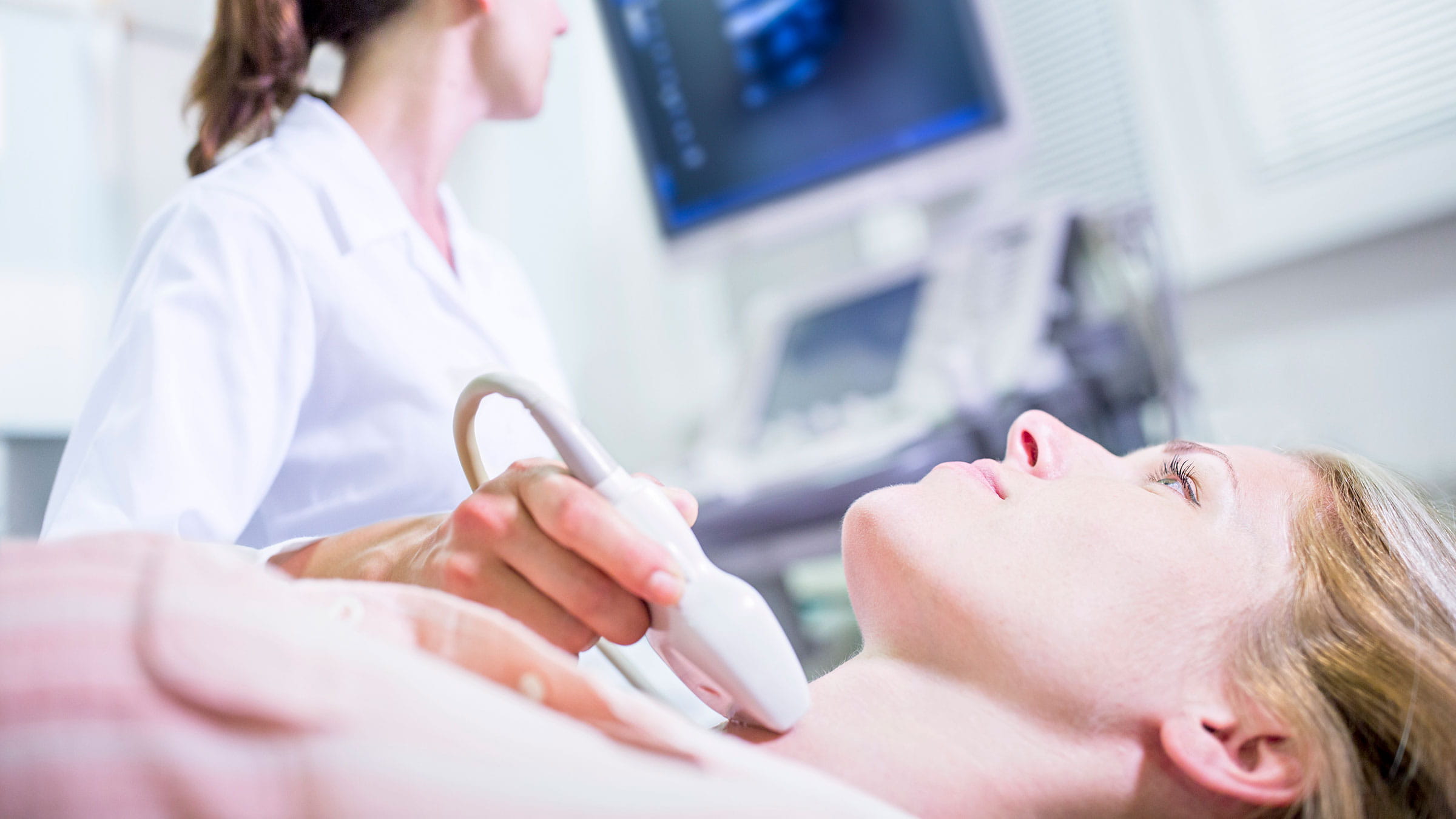Thyroid nodules, or lumps, are a common occurrence with more than half the U.S. population developing one by the age of 60.
While the vast majority of thyroid nodules are benign (95%), they can still cause problems leading to a need for treatment. Some nodules can grow large enough to cause pain, press on other important structures (airway or esophagus), or become cosmetically unpleasing. Nodules may also produce too much thyroid hormone leading to hyperthyroidism.
Previously, people with thyroid nodules had two options for treating thyroid nodules:
- Surgery
- Watch and wait
The Ohio State University Wexner Medical Center now offers a minimally invasive office-based procedure called thyroid radiofrequency ablation, or RFA. Thyroid RFA works by heating and destroying thyroid nodule tissue and leaves normal thyroid tissue untouched. This can completely eradicate some nodules. In larger nodules, the size is reduced by 50-80% in most patients allowing a reduction in symptoms experienced by a patient.
We’re the first health system in Columbus and the surrounding area to offer this groundbreaking procedure.
Why choose Ohio State for thyroid radiofrequency ablation?
As the first hospital in the area offering it, we’re able to provide key benefits that people dealing with thyroid nodules haven’t had access to previously. These benefits include:
- An office-based procedure
- No need for general anesthesia
- No surgical incision
- Minimal effect on thyroid gland’s functionality (no need for lifelong hormone medications)
As the addition of this new thyroid nodule treatment exemplifies, we’ve been pioneers in thyroid, adrenal and other endocrine issues for decades. Highlights of our program include:
- Specialists who have made this their life’s work – We have a number of endocrinologists and oncologists who specialize in treating thyroid diseases, including highly experienced surgeons. They’re constantly on the cutting edge of discoveries that ultimately lead to better outcomes and care. For example, we were one of the first hospitals to offer ethanol ablation of thyroid cysts.
- A nationally recognized diabetes and endocrinology team – U.S. News & World Report has ranked Ohio State 36th in the nation for excellence in the treatment of diabetes and endocrine disorders.
- An integrative approach – You’ll receive an individualized treatment plan while also having direct access to medical expertise from across the Ohio State Wexner Medical Center, including our world-renowned cancer providers at The Ohio State University Comprehensive Cancer Center – Arthur G. James Cancer Hospital and Richard J. Solove Research Institute.
Why is thyroid radiofrequency ablation done?
The main reason RFA is performed is to get rid of or at least decrease the size of thyroid nodules, which are solid or fluid-filled areas that form in your thyroid. The thyroid is a gland located in the lower half of the front of your neck. It drapes over the airway (trachea).
Thyroid nodules have various causes, including the overgrowth of normal tissue or build-up of fluid.
People with a thyroid nodule might consider having thyroid RFA performed, with guidance from their endocrinologist, for a variety of reasons, including:
- A nodule that is growing over time and is likely to continue to grow
- Thyroid nodules causing hyperthyroidism (overactive thyroid)
- Visible nodules causing cosmetic concerns
- Symptoms caused by the nodule, such as pain, trouble swallowing or trouble breathing
- An inability to undergo traditional surgery with general anesthesia
We’re still investigating other thyroid conditions that might benefit from this type of procedure.
People who are pregnant or have pacemakers should not undergo thyroid radiofrequency ablation.
Preparing for thyroid radiofrequency ablation
Prior to undergoing thyroid RFA, an ultrasound is performed and a biopsy of the nodule of concern is performed using a very small needle. This is also done in the office. Doctors want to know if a nodule is benign (noncancerous) or potentially cancerous before making a decision about performing thyroid RFA. In some instances, RFA can be used to treat small sites of recurrent thyroid cancer or thyroid cancer found in a single lymph node. Thyroid RFA in cancer patients is done much less often and after other considerations.
After you and your physician have decided that RFA is the right treatment for your thyroid nodule, you can take steps to ensure the procedure goes as smoothly as possible.
They include:
- Discuss any current medications with your doctor in advance of the day of the procedure
- Shower the morning of the procedure and wash the neck with soap and water
- Do not wear makeup or any jewelry to the appointment
- Have someone bring you to the appointment so you have a ride home
Additional information will be provided to you by your doctor.

What happens during thyroid radiofrequency ablation?
RFA involves the use of a small needle that emits radio waves to heat and destroy thyroid nodules.
Steps of the procedure include:
- Step One: You’ll lie down in the clinic room as the procedure is performed while you’re on your back.
- Step Two: A local anesthetic will be injected into the region around the thyroid nodule to numb the area.
- Step Three: Using an ultrasound machine for imaging guidance, your doctor will precisely place the ablation needle within the nodule. The needle will be maneuvered throughout the nodule to treat as much abnormal tissue as possible. Depending on the size of the nodule, this takes anywhere from 10 to 60 minutes to complete.
- Step Four: You’ll be asked to speak at certain times during the procedure to ensure the nerve that controls the vocal cords isn’t affected.
Is RFA painful?
Using over-the-counter pain medications, an anti-anxiety prescription and local anesthetic, nearly everyone tolerates the procedure well. Usually, no more than mild discomfort is experienced.
You might also feel and/or hear a bubbling or crackling sensation during the procedure. This is normal and not painful.
What is recovery like for thyroid radiofrequency ablation?
In the hours and days following your procedure, you can expect to feel some mild pain, which may include stiffness or soreness in your shoulders, back or neck as well as tension headaches. These symptoms are managed with over-the-counter anti-inflammatory medications, like ibuprofen and acetaminophen. These sensations decrease after several days. Ice packs in the first 24 hours can help.
You will also see some swelling and bruising as well as feel firmness in the area. Some may note changes in swallowing due to the nearby inflammation that is a normal part of healing. This may increase over the first week or two and then decrease over several weeks.
In about 1% of cases, your voice might become hoarse after the procedure, but this usually improves. There are additional procedures to improve the voice if needed.
Does thyroid radiofrequency ablation work?
Most people who undergo RFA at the Ohio State Wexner Medical Center should expect to see positive results following the procedure.
In some cases, especially involving small nodules, the entire nodule may disappear over time. In other cases, especially with large nodules, after the swelling subsides, people will see the size of their nodule decrease by 30-50% in the first month or two. It will continue to shrink over time, and after six months the nodule size decreases an average of 50-80%. In some cases involving very large nodules, additional ablation sessions may be required for patient safety and comfort.
It’s important to remember that it does take time to see these positive results and to not become alarmed with the initial swelling in the neck that most people experience following ablation.
Risks of thyroid radiofrequency ablation
Complications after RFA are rare, usually minor, and occur in only about 3-4% of people who undergo the procedure.
Risks include:
- pain
- hematoma (collection of blood)
- skin burns
- vomiting or fainting
- fever
- coughing
- lidocaine toxicity (avoided by calculating maximum dosage to give)
- thyroid nodule rupture
- nerve injury
- hypothyroidism
- injury to trachea or esophagus

